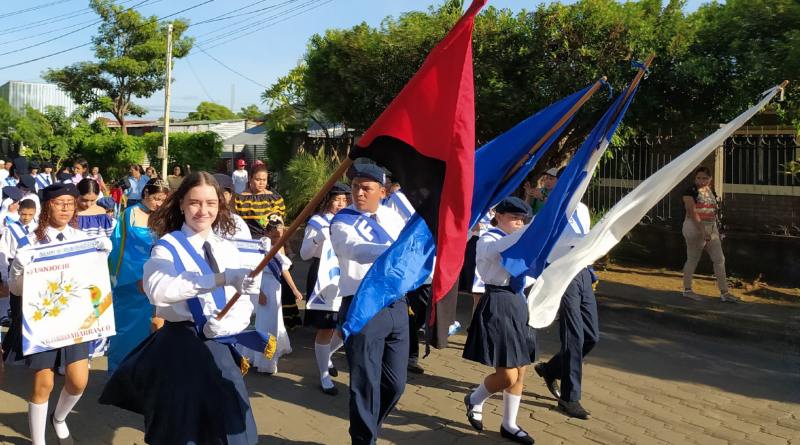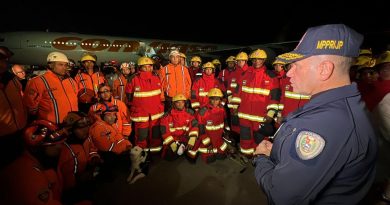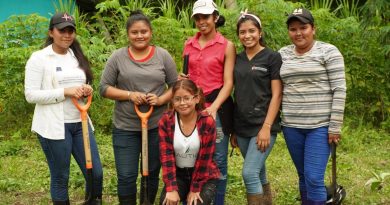Nicaragua: The Education Generation
By Becca Renk. Published by the Nicaragua Network, a project of Alliance for Global Justice.
Thanks to a complete overhaul of the country’s educational system in the past 15 years, record numbers of students are graduating from high school. Although recent international headlines claim academic spaces are closing in Nicaragua, there is now actually increased access to free public universities. That, combined with hundreds of free vocational programs around the country, means that the class of 2023 has more options open to them than ever before.
In a few short weeks, our youngest daughter Orla will graduate from high school. Recently I went to her school to watch as she and her friends marched in blue and white one final time to celebrate Nicaragua’s Independence. I’ll admit that I got nostalgic remembering Orla in her tiny blue and white preschool uniform marching around our neighborhood. At the same time, however, I felt such excitement for the lives these young people have ahead of them now.
Like all students nearing graduation, Orla and her friends are deciding what to do next. But while high school graduates in the United States this year are facing an average cost of $145,700 for a four-year undergraduate degree, Nicaragua’s graduates have a multitude of further education opportunities available to them for free.
It is difficult to grasp what a revolutionary change this is from just a generation ago. Orla’s friends’ parents grew up in Nicaragua’s neoliberal years when schools were so underfunded that children sat on the floor and used pilfered paving stones as desks. Their families were charged fees that made it impossible for many kids to attend school at all.
In 2003, the average Nicaraguan had only 3.5 years of schooling and only 30% of those starting 1st grade were expected to finish 6th grade. * As a result, by the time that Orla’s classmates were being born in 2006, only one quarter of the country was able to read or write. Many of Orla’s friends’ parents didn’t finish high school, let alone attend university, and a full quarter of their generation had no schooling at all.*
Orla’s class, however, has had a very different experience of education, because they represent the first generation to have attended their whole school career under Nicaragua’s current Sandinista government.
When President Daniel Ortega took office in 2007 following the 16 years of neoliberal rule [reduced social spending and state employment], he immediately declared health care and education free again. Over the past 16 years, the Sandinista government has made huge investments in training teachers, improving school infrastructure, and revolutionizing the school curriculum. The results of these policy changes are evident in the proud, confident students now posing for photos in cap and gown as they prepare to receive their high school diplomas – today, many more Nicaraguans are high school graduates.
But the revolution isn’t stopping there. As more young people graduate from high school, more are seeking further education. Through local municipal governments and a national technical school, there are now 53 vocational training centers around the country with more than 130 programs graduating 46,500 students annually.
Beyond technical training, there is now a wide variety of opportunities in public universities. While historically universities have been concentrated in the capital and a handful of other major cities, the Rural University program has now made third level education through distance learning possible in rural and Indigenous communities, educating 10,000 students annually in 60 municipalities.
Each year the offerings at public universities have grown, opening opportunities for the increasing number of students graduating from high school. This is why the government’s recent decision to nationalize one of the country’s largest private universities has been greeted with such enthusiasm in Nicaragua.
“Education for hire”
In August, the Nicaragua government nationalized the Jesuit-run Central American University (UCA), making it one of a number of private universities nationalized over the past few years. Far from being prohibited in Nicaragua, more than 30 private universities continue to thrive around the country. All educational institutions, however, must comply with regulations to ensure that students are receiving quality education. In the case of private universities, most were set up as non-profit institutions and so additionally they must comply with laws governing non-profits.
During the neoliberal years, large numbers of “garage universities” were set up in Nicaragua – so called because many of them were, in fact, nothing more than a converted garage offering college degrees for a price. Many of these institutions were not so much “higher education” as they were “education for hire” – they charged exorbitant fees to students in exchange for very little education, in flagrant violation of both educational and non-profit regulations.
“I met a kid who had graduated with a law degree from the Paolo Freire University,” a lawyer friend told me when speaking about one of the recently nationalized “garage” universities. “The poor guy didn’t even understand basic legal concepts, he got completely scammed.”
Following thorough investigations over the past three years by the National Universities Council (CNU) governing body, some private institutions have had their legal status revoked for failure to comply with minimum educational standards. Others have had their legal status revoked for failure to comply with non-profit regulations. This was the case of UCA, which had failed to provide annual financial reports for three consecutive years, as well as failure to elect a new Board of Directors when the previous one expired.
Nationalization, not closure.
In accordance with Nicaraguan law, when a non-profit has its legal status revoked due to failure to comply with regulations, its assets are transferred to the Nicaragua government. It is important to note that none of the universities that have had legal status revoked in Nicaragua have ceased to operate – rather, the government has taken over operation of the now-public universities without interruption to the studies of current students, all free of charge.
Because of this policy, simultaneously with the announcement that the legal status of the UCA had been revoked, the National Universities Council announced the opening of a new public university in its place, the Casimiro Sotelo University.
Fees at the former UCA amounted to nearly $700 per semester, far outside the price range of most Nicaraguan families, despite the fact that the UCA received US$16 million yearly from the government. In contrast, fees at the new Casimiro Sotelo University will be limited to the standard $5.50 per semester registration fee. This decision is so popular that when the president of the CNU announced it at the university’s opening, the cheers from the public drowned out her next remarks.
In fact, I have yet to speak to anyone in Nicaragua who is against the nationalization of the now-defunct UCA. I have spoken to parents who are excited for their kids to have the opportunity to apply to study there. I have spoken to former students who were forced to drop out due to cost and have now been contacted and invited to come back to finish their degrees free of charge. I have even spoken to one father of a current student who was hoping the university would be nationalized; he’s thrilled that he no longer has to pay fees for his son to receive the same education.
The luxury of choice
Thanks to Nicaragua’s commitment to the future of Orla’s Education Generation, there have been radical changes in the options now available, and her graduating class is free to make different decisions than their parents made.
While Nicaragua used to have the highest teen pregnancy rate in the region, young people are now waiting until their twenties – and even late twenties – to have a family. They are also studying more than ever – the percentage of Nicaraguans with university degrees has risen from 9% to 19%** in just 15 years and Nicaragua now ranks high with a parity score of one (along with other countries) in the world for educational attainment for women and girls, followed (in Latin America) by .999 for Costa Rica and .998 for Panama.
With so many options, Orla and many of her classmates haven’t yet decided what to do next. So, this week they took an online quiz through the Ministry of Education where they answered questions about their interests and were matched with options for different areas of study and the technical courses or universities that offer those programs. Orla’s results matched her interests with 86 different majors or programs at 56 free technical schools, 46 free public university campuses as well as private universities.
As these young graduates turn to their next adventure, they not only have options available to them, they also have the luxury to figure it out without worrying about how to pay fees or going into debt to receive an education.
*United Nations Development Program, 2003
**Plan de Lucha Contra la Pobreza Para el Desarrollo Humano 2022-2026
Becca Renk is originally from the U.S. and has lived and worked in Nicaragua since 2001 with the Jubilee House Community and its project the Center for Development in Central America. She and her husband Paul have two daughters who have studied in Nicaraguan public schools for 15 years.



